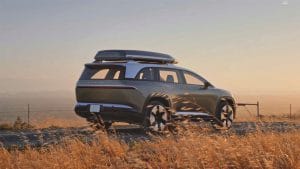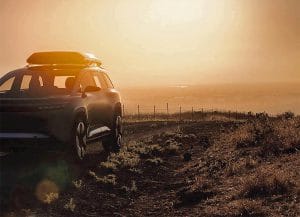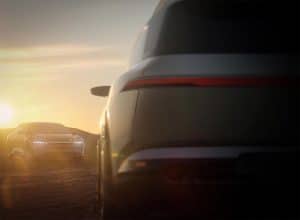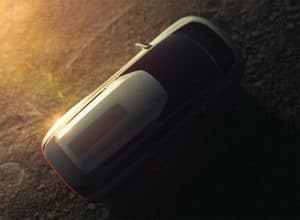It can be difficult to defy gravity – or so Lucid Motors is hoping. Even as it formally unveils its first battery-electric vehicle, the California start-up is teasing a second model, the Lucid Gravity. And, in an SUV-crazed market, the company is betting this is where its push for real volume will begin.
While Lucid revealed few details during a nearly two-hour web session Wednesday night, company officials provided a few critical insights into their plans for Gravity during a series of one-on-one interviews with TheDetroitBureau.com. Set to start rolling out in 2023, it will, for one thing, share the underlying, skateboard-like architecture developed for the Lucid Air sedan and deliver much the same level of performance and range.
“We’re not just launching a car. We’re launching a brand,” Lucid design director Derek Jenkins said during Wednesday night’s webinar. And for that brand, he added, “We’re already working on several different projects, beyond Lucid Air, beyond Lucid Gravity.”
(Taking flight: Lucid launches its Air EV.)
But more on what will came later this decade in a moment.
What we can readily gather from these teaser images of the Lucid Gravity that is features many design cues lifted from the Air sedan. That starts with the slit-style light bar, with its distinctive array of “micro-lens” LED headlamps, up front.
And, like the sedan, there’s no traditional grille, just a modest-sized intake in the lower fascia with electrically operated shutters that can open up when cooling air is needed for motors and electronics, typically under aggressive driving conditions. Otherwise, the shutters remain closed to reduce wind drag.
Other steps to reduce drag are obvious on the back of the SUV, though the back end is far cleaner than some of the other “aero” models of recent years, such as the Nissan Leaf, which used protruding light fixtures and other tricks to cheat the wind. There is a modest spoiler at the top of Gravity’s rear hatch, but it also picks up the broad lightbar from Air – which Jenkins claims to be the widest rear lighting assembly in the industry. The prototype in these images also features special, low drag wheels.
Aerodynamics are key to what Lucid CEO calls the company’s “smart” range strategy, maximizing the energy efficiency of every aspect of a vehicle, rather than just loading it up with as big a battery pack as possible. In an interview ahead of the Air debut, Rawlinson told us that he expects the Lucid Gravity to deliver similar levels of range and performance to the Air sedan, no mean feat considering its taller stance and, most likely, greater mass.
That would mean, if it pans out, that various versions of the electric SUV could deliver more than 500 miles per charge, hit 60 mph in less than 2 seconds and run a dragstrip’s quarter-mile faster than cars like the Ford Mustang GT 500. (Lucid is claiming a 9.9-second run through the traps for Air, but Rawlinson told us he actually beat that time.)
We can expect Gravity to offer a battery pack similar to that of the Air, which features as much as 110 kilowatt-hours in the Grand Touring and Dream Edition.
As for the powertrain, the LEAP architecture – short for Lucid Electric Advanced Platform – can fit anywhere from one to three motors. The initial, four variants of Air will offer either one or two, with a three-motor GT package to follow. Power currently tops out at 1,080 horsepower but will reach around 1,300 with the high-performance model. Expect a similar strategy with the Lucid Gravity.
(Lucid Air aims to blow away the competition — at least on the dragstrip.)
One of the interesting features seen in these teaser images is the customized rooftop storage unit which, in the overhead pic, has the Lucid name embossed in its cover. This might hint at a line of accessories to come from the automaker.
We don’t get to see the prototype Gravity’s interior but it’s likely to adopt many of the design elements of the Air sedan, including the 34-inch primary display and secondary touchscreen control panel. It would seem likely that seating would be similar, including the power fold-down rear buckets. We’ll have to wait to see if Gravity is offered with a three-row configuration but that could be likely.
One of the benefits of using a skateboard-like platform for EVs, with batteries and most powertrain components tucked below the floor, is that this offers a substantially larger interior package than the exterior footprint would suggest, Jenkins said in his interview.
The design chief also hinted that Gravity could be even more upscale than the sedan and find application in the executive transportation segment.
According to Rawlinson, Lucid is taking a go-it-slow approach to sales, targeting less than 10,000 in its first year. But it will have the capacity to push as high as 400,000 with its new factory near Phoenix which uses a modular layout that, the company claims, can quickly be expanded to take advantage of growing demand.
With prices starting “below $80,000” for the base Air sedan coming in 2022, demand is likely to be modest, much as was the case for the original Tesla Model S. In today’s crossover-crazed market, the company expects the Lucid Gravity to be more popular.
But any real growth will have to wait for the next generation of products, Rawlinson said, the company already working on a second platform for products that, he vaguely hinted, would fall more into the Tesla Models 3 and Y segments, at substantially lower price points.
For his part, designer Jenkins also hinted at that move during the Wednesday night webinar, adding “We’re looking at a broader range of cars seven to 10 years out.”
(Lucid Air to offer biggest battery pack of any EV — and longest range.)
But Lucid has even broader aspirations, said Rawlinson. It not only plans to build cars but – borrowing a page from Tesla – stationary power systems. And he sees plenty of other applications for Lucid’s compact and powerful driveline, notably for electric aircraft, as well as in military applications.






I don’t understand why you publish these ‘free ads’ for a company that has nothing and may never have anything. Can’t you wait till they can produce a vehicle you can drive and evaluate? Anyone can make claims, but only a few can actually produce.
These aren’t “free ads.” They are legitimate news stories about companies that could change the transportation world. You realize we got the same criticism a decade ago with early pieces about Tesla which, today, is one of the most popular topics in any auto publication, the company dominating the EV market and boasting a market cap twice that of Toyota. As with everything else, we try to cover these new players judiciously, meaning balanced coverage that has often been quite harsh. We were on top of the collapse of companies like Fisker Motors and Faraday, for example. And we’ve frequently raised questions about Lucid’s viability. That said, there are plenty of reasons to now take the Air seriously and provide the close-up we’re offering. See the two Q&As with Lucid execs to come later today.
Paul E.